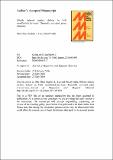Files in this item
Silicide induced surface defects in FePt nanoparticle fcc-to-fct thermally activated phase transition
Item metadata
| dc.contributor.author | Chen, Shu | |
| dc.contributor.author | Lee, Stephen L. | |
| dc.contributor.author | André, Pascal | |
| dc.date.accessioned | 2017-06-01T23:33:52Z | |
| dc.date.available | 2017-06-01T23:33:52Z | |
| dc.date.issued | 2016-11-01 | |
| dc.identifier | 243265180 | |
| dc.identifier | 4ab6c37a-4d1c-4c64-b30a-7cc94691fe96 | |
| dc.identifier | 84973577753 | |
| dc.identifier | 000379147500066 | |
| dc.identifier.citation | Chen , S , Lee , S L & André , P 2016 , ' Silicide induced surface defects in FePt nanoparticle fcc -to- fct thermally activated phase transition ' , Journal of Magnetism and Magnetic Materials , vol. 417 , pp. 442-450 . https://doi.org/10.1016/j.jmmm.2016.05.099 | en |
| dc.identifier.issn | 0304-8853 | |
| dc.identifier.other | RIS: urn:049C697821C208B0CACFE26987B82A81 | |
| dc.identifier.other | ORCID: /0000-0002-2020-3310/work/54995375 | |
| dc.identifier.uri | https://hdl.handle.net/10023/10897 | |
| dc.description | The authors would like to thank the James and Enid Nicol Trust for funding SC's studentship, the Canon Foundation in Europe for supporting PA's visits at the RIKEN and his Fellowship, and the Ministry of Science, ICT & Future Planning, Korea (201000453, 2015001948, 2014M3A6B3063706) for hosting PA's visits during the final write-up and submission stages of the manuscript. | en |
| dc.description.abstract | Magnetic nanoparticles (MnPs) are relevant to a wide range of applications including high density information storage and magnetic resonance imaging to name but a few. Among the materials available to prepare MnPs, FePt is attracting growing attention. However, to harvest the strongest magnetic properties of FePt MnPs, a thermal annealing is often required to convert face-centered cubic as synthesized nPs into its tetragonal phase. Rarely addressed are the potential side effects of such treatments on the magnetic properties. In this study, we focus on the impact of silica shells often used in strategies aiming at overcoming MnP coalescence during the thermal annealing. While we show that this shell does prevent sintering, and that fcc-to-fct conversion does occur, we also reveal the formation of silicide, which can prevent the stronger magnetic properties of fct-FePt MnPs from being fully realised. This report therefore sheds lights on poorly investigated and understood interfacial phenomena occurring during the thermal annealing of MnPs and, by doing so, also highlights the benefits of developing new strategies to avoid silicide formation. | |
| dc.format.extent | 1752537 | |
| dc.language.iso | eng | |
| dc.relation.ispartof | Journal of Magnetism and Magnetic Materials | en |
| dc.subject | Iron platinum | en |
| dc.subject | Annealing | en |
| dc.subject | Silica | en |
| dc.subject | Silicide | en |
| dc.subject | Effect | en |
| dc.subject | QC Physics | en |
| dc.subject | NDAS | en |
| dc.subject.lcc | QC | en |
| dc.title | Silicide induced surface defects in FePt nanoparticle fcc-to-fct thermally activated phase transition | en |
| dc.type | Journal article | en |
| dc.contributor.sponsor | EPSRC | en |
| dc.contributor.institution | University of St Andrews. School of Physics and Astronomy | en |
| dc.contributor.institution | University of St Andrews. Condensed Matter Physics | en |
| dc.identifier.doi | 10.1016/j.jmmm.2016.05.099 | |
| dc.description.status | Peer reviewed | en |
| dc.date.embargoedUntil | 2017-06-01 | |
| dc.identifier.grantnumber | EP/I031014/1 | en |
This item appears in the following Collection(s)
Items in the St Andrews Research Repository are protected by copyright, with all rights reserved, unless otherwise indicated.

